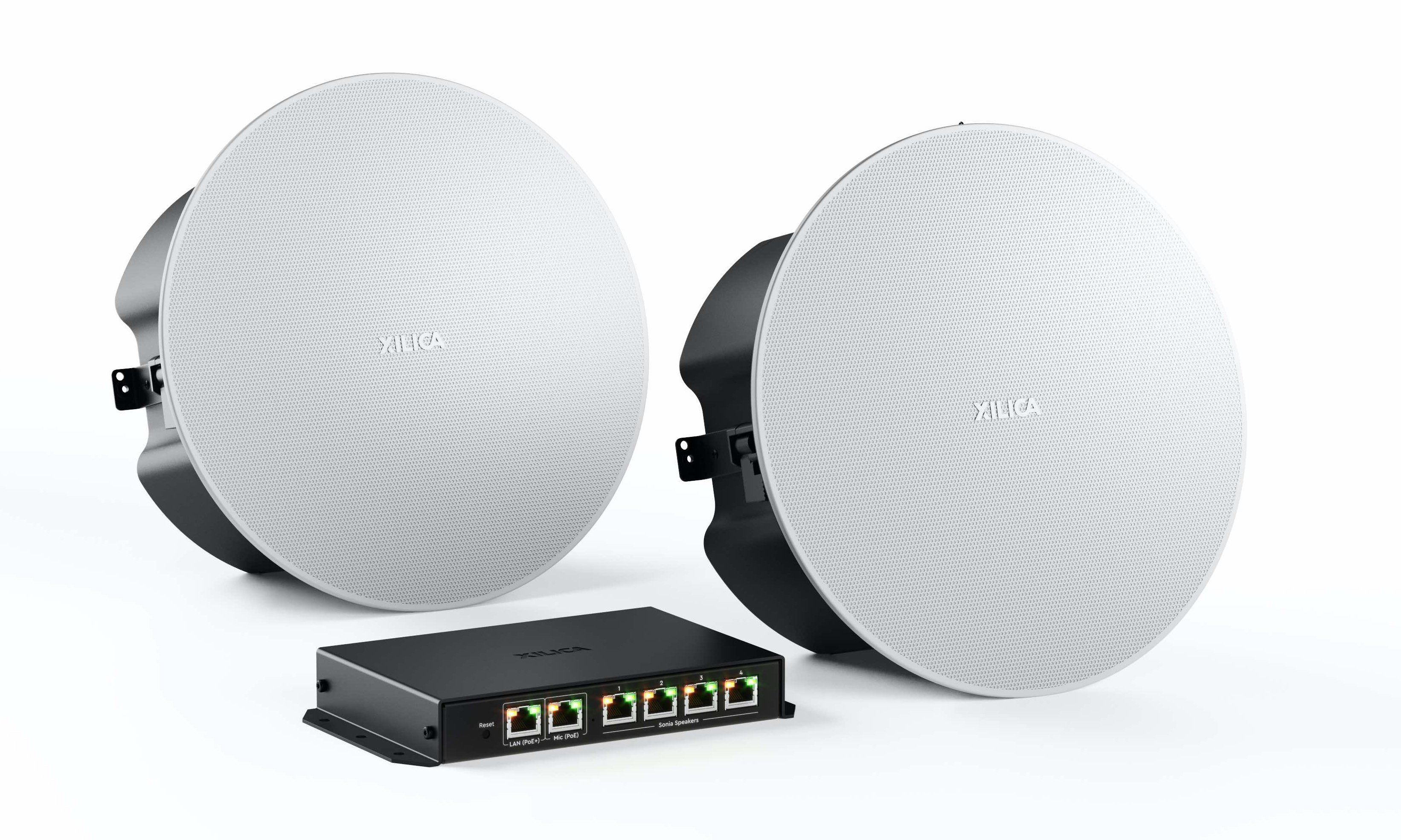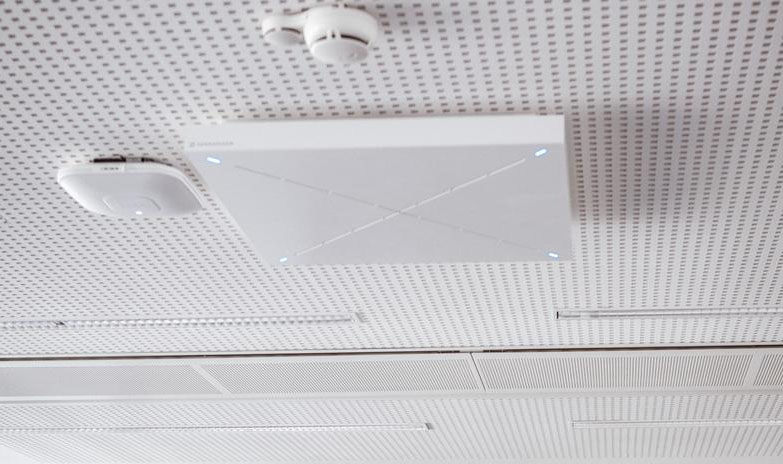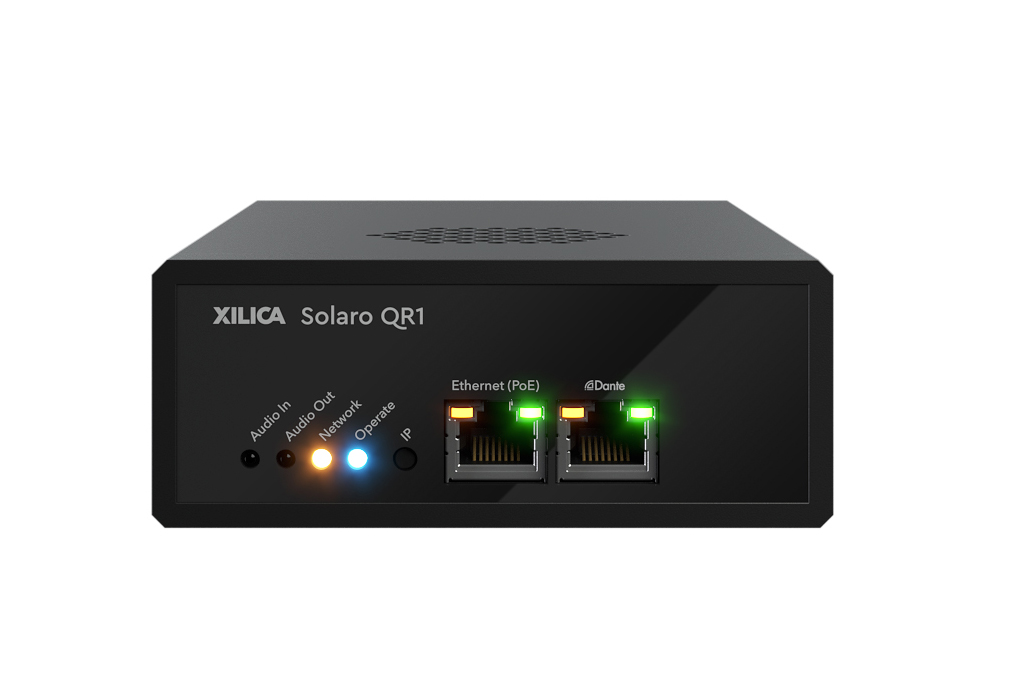Review: Conferencing Clarity
The Sennheiser and Xilica Medium Room Kit makes audio easy for your next meeting.

Videoconferencing has become the norm since the pandemic. During the isolation stage, people were Zooming rather than traveling to meetings. As a result, the quality of the visuals and sound needed to rise to a new level, so all parties could see and hear everything clearly.
[Look Up, Listen Up with These 9 Ceiling Mics]
Sennheiser, a trusted name in sound and conference room audio technology, and Xilica, with its state-of-the art amplification and speakers system, have partnered and created the Sennheiser and Xilica Medium Room Kit, which contains the TeamConnect Ceiling 2 (TCC2) Microphone Array, Xilica Solaro QR1 digital signal processor, Sonia Amp, and Sonia C5 speaker system.
Parsing the Parts
Examining the Sennheiser microphone system first, the square, ceiling-mounted TCC2 utilizes 28 Sennheiser KE 10-237 microphone capsules and the company's automatic dynamic beamforming technology to find and focus on who may be speaking, wherever they might be within the room. If a specific area of the room needs to be singled out, a priority zone can be established, and unwanted noise sources may be removed via its exclusion zone software.
Obviously, the human voice is the most critical factor when capturing audio in a meeting or conference. Using Sennheiser's TruVoicelift technology, the intelligibility of the speech is increased and amplified. The TCC2 may be mounted on the ceiling one of three ways: slightly below the ceiling, suspended from it, or flush using the extension brackets.

The back of the unit contains the connection ports: Dante primary and secondary Ethernet (RJ45) sockets for redundancy, three-pin analog out (for Phoenix Contact MCVW 1.5-3-ST-3.81), and the Ethernet Power over Internet (PoE)/Ctrl socket, if you’re using software or a media control system to configure the system. There's also a reset button that restores everything to the factory settings.
The next item in the chain is the Solaro QR1 DSP. The 2-pound, 6x4x1.65-inch black box mounts almost anywhere using the supplied mounting brackets. My review unit had five installed card bays and three blanking cards.
A daily selection of the top stories for AV integrators, resellers and consultants. Sign up below.
[SCN Hybrid World: Better Heard, Not Seen]
Internally, the dual core Linux processor with 40-bit floating point architecture handles all your audio filtering needs. On the front panel, LEDs indicate an active audio input, audio output, network connection, and power. There are also two RJ45 ports for PoE and Dante. The back of the QR1 includes an analog audio in, general purpose I/O (GPIO), analog audio out, and 2x2 USB audio.

To amplify and power your room’s speakers, Xilica's Sonia Amp four-channel audio amplifier fits the bill. Also powered by an Ethernet connection, up to eight speakers can fill the environment with sound. Not needing the usual copper speaker wire, Ethernet (RJ45) and Category cable make the installation faster. The fanless, convection-cooled amp weighs less than a pound and mounts easily to the back of any C5 speaker.
Just one Category cable drop is needed for the entire system. The amplifier offers up to 15 watts for a single channel of audio and consumes only 30 watts when powered by a PoE+ network or power injector. The back of the amp has a reset button, Ethernet LAN and microphone port, and four Ethernet Sonia speaker ports. The microphone port provides network connectivity and PoE power to the ceiling microphone array, eliminating the need for additional cable drops.
Completing the system are the 5.25-inch, 5.5-pound Sonia C5 Speakers using Ethernet cabling. These suspended ceiling speakers mount with the included tile brackets. The 8 ohm loudspeaker has a low-frequency 5.25-inch transducer and a .75-inch-high frequency transducer, and delivers a 180-degree angle of sound.
Each speaker has four ceiling panel clamps in the rear, which secure the speaker to the ceiling tile, as well as two Ethernet connections under a screw-secured connector cover. If you are using two speakers, attach an Ethernet cable to one speaker’s input and the other end to the Sonia Amp, then connect the second speaker to the first speaker via Ethernet. Both the Sonia Amp and Sonia C5 speakers are plenum-rated.
Cable Junkie
When I first received the Medium Room Kit, my initial intention was to mount the TCC2 flush with the drop ceiling in our new wing’s conference room. However, due to construction delays (thanks, supply chain), I instead decided to use our existing 15x20-foot conference room. The installation instructions included were easy to follow, and with the extension brackets, everything I needed was included.
The Sennheiser Control Cockpit is an optional but very useful accessory. Although not required, it helps with the specific configuration of your TCC2 and allows live monitoring while in use. Without this piece of equipment, however, I couldn’t test canceling out specific noises or selecting whom I wanted the microphones to follow.
[Review: How to Produce an Affordable Podcast with Multiple Mics]
Before I could begin with the installation, though, I loaded up on Ethernet cable. Using a Non-DHCP enabled network, I needed to manually enter the IP address information from the Xilica Designer software after I installed it on my PC. Then, I ran an Ethernet cable from the PC to the Xilica Solaro QR1 LAN RJ45 port (cable one).
Using the Xilica Sonia Amp, the Ethernet cable looped from the QR1 to the LAN (PoE) port (cable two), then connected the mic output to the input on the Sennheiser TCC2 to power the microphone array (cable three). Still another Ethernet cable attached to the Sonia Speaker input on the Amp (cable four) and out to one of the C5 speakers (cable five), with the last Ethernet cable looped from the other free C5 port to the second speaker (cable six).
The Solaro QR1 does improve and enhance the understanding of the human voice. Every environment has acoustical obstacles to overcome, from walls to windows to ceilings, etc. None of this seemed to be a problem for the QR1. Anytime I can sound more intelligent, I’ll take it. (I guess I’ll have to carry the QR1 with me everywhere.)
For our temporary install, I used our existing conference room with a 10-foot suspended ceiling. The TCC2 was attached with clamps to the suspended ceiling. The QR1 and Sonia Amp remained on the conference room table, while the two speakers were setup on C-stands at about head level. Again, this was a makeshift, not permanent, arrangement.
I saw very few challenges with setup. You don't really need extensive installation skills, and it's essentially a plug-and-play system. As long as you have the components, you are just connecting everything together. I would recommend having someone familiar with cutting the Ethernet cable to length from a spool and adding the connectors.
Ready to Talk?
The TCC2’s sound was excellent. Sounding like a high-end lavaliere (rather than a shotgun microphone), the mics in the array clearly picked up each speaker with an almost omnidirectional pattern. There was room noise that the Sennheiser Cockpit Control would have eliminated, but the extraneous noise wasn’t overly objectionable. Once installed, the TCC2 is forgotten and blends in with the existing ceiling. I was distracted slightly by the blue lights, but that’s just me.
[SCN Hybrid World: 11 Speakerphones for Today's Workspace]
The Sonia C5 speakers spread the sound throughout the room nicely. Many factors could have hindered that, including the number of people in the room, as well as the fact that hard surfaces reflect sound and soft surfaces absorb sound. I’m not an engineer, but if the speakers make the sound clear and understandable, I’m happy.
The Zoom meeting began and the Sennheiser array picked up the sound from both sides of the room. As the test subject, I purposely walked around the room to see if the sound was picked up. Not having the Sennheiser Control Cockpit, I couldn’t map out exactly what I wanted, but the sound was great, anyway.
The Sennheiser and Xilica Medium Room Kit has everything you need for your online meetings, apart from cabling. Installation is a breeze—and considering the same type of cable connects it all together and supplies power, there’s nothing keeping you from sounding better for your next meeting.
Chuck Gloman, Associate Professor, has more than 40 years of experience as a producer and director of photography with more than 900 TV commercials, 250 corporate videos, and 100 documentaries to his credit. His films have aired on HBO, Cinemax, and network television. He is the author of Placing Shadows: The Art of Video Lighting, 2nd Edition (Focal Press: 2000); No Budget Digital Filmmaking (McGraw-Hill: 2002); 303 Digital Filmmaking Solutions (McGraw-Hill: 2002); 202 Digital Photography Solutions (McGraw-Hill: 2003); Placing Shadows: The Art of Video Lighting, 3rd Edition (Focal Press: 2005); Scenic Design and Lighting Techniques (Focal Press: 2006); Working with HDV (Focal Press: 2006); Placing Shadows: The Art of Video Lighting, 3rd Edition (translated in Japanese Language Focal Press: 2007); and Placing Shadows: The Art of Video Lighting, 3rd Edition (translated in Chinese Language Focal Press: 2017). He has published more than 500 articles.

